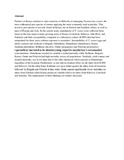Susceptibility of geographically isolated populations of the Tomato red spider mite (Tetranychus evansi Baker & Pritchard) to commonly used acaricides on tomato crops in Kenya

Date
2014Author
Toroitich, F J
Knapp, M
Nderitu, J H
Olubayo, F M
Obonyo, M
Language
enMetadata
Show full item recordAbstract
Farmers in Kenya continue to raise concerns of difficulty in managing Tetranychus evansi, the most widespread pest species of tomato applying the most commonly used acaricides. This invasive pest species is not only found in Kenya, but in Eastern and Southern Africa, as well as parts of Europe and Asia. In the current study, populations of T. evansi were collected from farms in the four major tomato-growing areas of Kenya (Loitoktok, Kibwezi, Athi-River and Subukia) and their susceptibility compared to a laboratory culture (ICIPE) that had been maintained for three years without exposure to acaricides. Susceptibility of T. evansi eggs and adults (contact and residual) to Brigade (bifenthrin), Dimethoate (dimethoate), Karate (lambdacyhalothrin), Kelthane (dicofol), Omite (propargite) and Polytrin (profenofos+ cypermethrin) was tested in the laboratory using respective manufacturer’s recommended concentrations. Dimethoate resulted in variable ovicidal mortality while Kelthane, Brigade, Karate, Omite and Polytrin had high mortality across all populations. Similarly, adult contact and residual mortality was lower than that of the other chemicals when exposed to Dimethoate regardless of the location. Furthermore, it also had no residual effect on the mites from ICIPE and Kibwezi. On the other hand, Kelthane was most lethal against the mites from all locations followed by Brigade and Polytrin in that order. Omite caused significantly lower mortality on mites from Subukia while Karate produced variable effects on mites from Kibwezi, Loitoktok and Subukia. The implications of these findings are further discussed.
Citation
Toroitich, F. J., Knapp, M., Nderitu, J. H., Olubayo, F. M., & Obonyo, M. (2014). Susceptibility of geographically isolated populations of the Tomato red spider mite (Tetranychus evansi Baker & Pritchard) to commonly used acaricides on tomato crops in Kenya. Journal of Entomological and Acarological Research, 46(1), 18-25.Publisher
University of Nairobi
